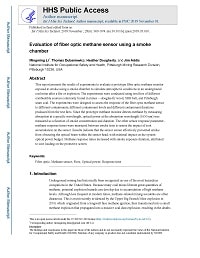Mining Publication: Evaluation of Fiber Optic Methane Sensor Using a Smoke Chamber
Original creation date: November 2018
Authors: M Li, T Dubaniewicz, H Dougherty, J Addis
This report presents the results of experiments to evaluate a prototype fiber optic methane monitor exposed to smoke using a smoke chamber to simulate atmospheric conditions in an underground coal mine after a fire or explosion. The experiments were conducted using test fires of different combustible sources commonly found in mines —douglas-fir wood, SBR belt, and Pittsburgh seam coal. The experiments were designed to assess the response of the fiber optic methane sensor to different contaminants, different contaminant levels and different contaminant durations produced from the test fires. Since the prototype methane monitor detects methane by measuring absorption at a specific wavelength, optical power at the absorption wavelength (1650 nm) was measured as a function of smoke concentration and duration. The other sensor response parameter-methane response times-were measured between smoke tests to assess the impact of soot accumulation on the sensor. Results indicate that the sensor screen effectively prevented smoke from obscuring the optical beam within the sensor head, with minimal impact on the system optical power budget. Methane response times increased with smoke exposure duration, attributed to soot loading on the protective screen.

- Cableless Electronic Surveying Systems for Horizontal Holes
- Evaluation of IYONI II Methanometers
- Evaluation of Person-Wearable Methane Monitors
- Factors Affecting the Location of Methanometers on Mining Equipment
- Ignition of Methane-Air Mixtures by Laser Heated Small Particles
- Methane Emission Rate Studies in a Northern West Virginia Mine
- Remote Methane Sensors
- A Second-Generation Remote Optical Methanometer
- Use of a Test Box to Measure Response Times for Machine-Mounted Monitors
- Use of Infrared Sensors for Monitoring Methane in Underground Mines